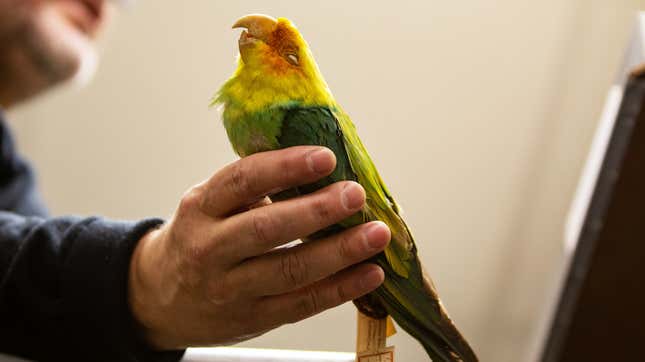
Researchers have produced the first whole genome of the Carolina parakeet, a recently extinct parrot native to the United States. The bird’s DNA reveals that humans (and probably humans alone) brought about its abrupt extinction.
The Carolina parakeet was one of only two parrots native to the U.S., but it went extinct in 1918, when the last surviving individual died at the Cincinnati Zoo. Scientists still wonder what happened to this colorful bird, since there are various potential factors that might have caused it harm. But the parakeet’s genome shows little evidence of species decline before its extinction.
“Some species become extinct at the end of a long demographic decline, while others experience sudden a disappearance,” the study’s corresponding author, Carles Lalueza-Fox from the Institute of Evolutionary Biology in Barcelona, Spain, told Gizmodo in an email. “In the former case, human action is common. In the case of the Carolina parakeet—as well as the passenger pigeon—there is this paradoxical observation of seemingly innumerable specimens and yet quick extinctions, on the order of few decades”
The colorful Carolina parakeets roved the American Southeast in large, noisy, and destructive flocks. They were well known for being toxic to other animals, being one of the only species that ate poisonous cocklebur. But bird observers as early as John James Audubon noticed that their populations were declining, and he wrote in 1832: “Our Parakeets are very rapidly diminishing in number; and in some districts, where twenty-five years ago they were plentiful, scarcely any are now to be seen.” The parakeet’s wooded habitats were quickly cleared for agriculture when colonists arrived, and they were shot in great numbers by hunters or farmers who treated the birds as pests.
But scientists have been unsure of the full story surrounding its demise. It was possible that exposure to livestock disease or its fondness for eating poisonous seeds played a role.
The researchers collected samples from the leg bone and toe pads of a preserved pet Carolina parakeet specimen and processed them to extract DNA. The researchers also extracted DNA from a single sun conure, the closest living relative to the Carolina parakeet, whose genome they could use as a reference while putting together the Carolina parakeet’s genome.
Even from just one individual, the researchers were able to make some observations of the parakeet’s evolution. The Carolina parakeet population increased between 760,000 years and 126,000 years ago and fluctuated since then, including a constant population decline until recent times. But the sun conure’s population decline seemed much stronger over more time, according to the paper published today in Current Biology. The researchers also found locations in the Carolina parakeet genome that produced different amino acids than the sun conure, which might explain the parakeet’s ability to digest cocklebur poison.
Despite evidence of the population decline, the researchers did not find the dramatic signals of decreased genetic diversity that they would expect to find in a species on the brink of extinction—in fact, these signals were stronger in the sun conure genome.
“Scarce evidence of inbreeding indicates that it suffered a very quick extinction process that left no traces in the genomes of the last specimens,” the researchers write in the paper. “In fact, the bird’s final extinction was likely accelerated by collectors and trappers when it became evident that it was extremely rare.”
The study was a thorough one that took a lot of work and revealed interesting new insights about the bird’s demise, said Jessica Thomas, a scientific officer based at Swansea University who was not involved in the study but who has worked with this team before. She told Gizmodo in an email that she agreed with the study’s conclusions, but she noted that more work could bolster these findings. “Despite using the full genome, they have only used one individual from which they have drawn these conclusions. While using one genome is common in this type of study, supplementing the data with more samples, even by using more mitochondrial genomes, could add even more strength to the analysis.”
Thomas herself published an analysis of another recently extinct bird’s genome, the great auk. Those results similarly show that humans were the biggest driver of that species’ extinction—specifically, centuries of hunting, with specimen collectors issuing the final blow.
Lalueza-Fox is interested in the processes behind extinction and whether this research might one day be useful in de-extinction, he told Gizmodo. This work once again demonstrates that humans have a profound impact the natural world, one which has led to the demise of countless species.